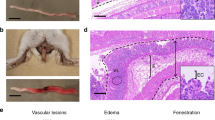Abstract
Cholera is an epidemic diarrheal disease caused by Vibrio cholerae that continues to cause significant morbidity and mortality in many parts of the world. Several different animal models have been used by scientists over the years to study the pathogenesis of cholera. However, the most commonly used is the infant (suckling) mouse model, which has been found to replicate important aspects of human intestinal colonization. Here we present a detailed protocol for using the infant mouse model to assess the colonization of V. cholerae strains using a competition assay.
Access this chapter
Tax calculation will be finalised at checkout
Purchases are for personal use only
Similar content being viewed by others
References
Richardson SH (1994) Animal models in cholera research. In: Wachsmuth IK, Blake PA, Olsvik Ø (eds) Vibrio cholerae and cholera: molecular to global perspectives. ASM Press, Washington, DC
Klose KE (2000) The suckling mouse model of cholera. Trends Microbiol 8:189–191
Butterton JR, Ryan ET, Shahin RA, Calderwood SB (1996) Development of a germfree mouse model of Vibrio cholerae infection. Infect Immun 64:4373–4377
Baselski VS, Upchurch S, Parker CD (1978) Isolation and phenotypic characterization of virulence-deficient mutants of Vibrio cholerae. Infect Immun 22:181–188
Chiang SL, Mekalanos JJ (1998) Use of signature-tagged transposon mutagenesis to identify Vibrio cholerae genes critical for colonization. Mol Microbiol 27:797–805
Iredell JR, Stroeher UH, Ward HM, Manning PA (1998) Lipopolysaccharide O-antigen expression and the effect of its absence on virulence in rfb mutants of Vibrio cholerae O1. FEMS Immunol Med Microbiol 20:45–54
Hughes KJ, Everiss KD, Kovach ME, Peterson KM (1995) Isolation and characterization of the Vibrio cholerae acfA gene, required for efficient intestinal colonization. Gene 156:59–61
Franzon VL, Barker A, Manning PA (1993) Nucleotide sequence encoding the mannose-fucose-resistant hemagglutinin of Vibrio cholerae O1 and construction of a mutant. Infect Immun 61:3032–3037
Camilli A, Mekalanos JJ (1995) Use of recombinase gene fusions to identify Vibrio cholerae genes induced during infection. Mol Microbiol 18:671–683. https://doi.org/10.1111/j.1365-2958.1995.mmi_18040671.x
Henderson DP, Payne SM (1994) Vibrio cholerae iron transport systems: roles of heme and siderophore iron transport in virulence and identification of a gene associated with multiple iron transport systems. Infect Immun 62:5120–5125
Taylor RK, Miller VL, Furlong DB, Mekalanos JJ (1987) Use of phoA gene fusions to identify a pilus colonization factor coordinately regulated with cholera toxin. Proc Natl Acad Sci U S A 84:2833–2837
Herrington DA, Hall RH, Losonsky G, Mekalanos JJ, Taylor RK, Levine MM (1988) Toxin, toxin-coregulated pili, and the toxR regulon are essential for Vibrio cholerae pathogenesis in humans. J Exp Med 168:1487–1492
Angelichio MJ, Spector J, Waldor MK, Camilli A (1999) Vibrio cholerae intestinal population dynamics in the suckling mouse model of infection. Infect Immun 67:3733–3739
Champion GA, Neely MN, Brennan MA, DiRita VJ (1997) A branch in the ToxR regulatory cascade of Vibrio cholerae revealed by characterization of toxT mutant strains. Mol Microbiol 23:323–331
Lee SH, Hava DL, Waldor MK, Camilli A (1999) Regulation and temporal expression patterns of Vibrio cholerae virulence genes during infection. Cell 99:625–634
Author information
Authors and Affiliations
Corresponding author
Editor information
Editors and Affiliations
Rights and permissions
Copyright information
© 2018 Springer Science+Business Media, LLC, part of Springer Nature
About this protocol
Cite this protocol
Matson, J.S. (2018). Infant Mouse Model of Vibrio cholerae Infection and Colonization. In: Sikora, A. (eds) Vibrio Cholerae. Methods in Molecular Biology, vol 1839. Humana Press, New York, NY. https://doi.org/10.1007/978-1-4939-8685-9_13
Download citation
DOI: https://doi.org/10.1007/978-1-4939-8685-9_13
Published:
Publisher Name: Humana Press, New York, NY
Print ISBN: 978-1-4939-8684-2
Online ISBN: 978-1-4939-8685-9
eBook Packages: Springer Protocols




